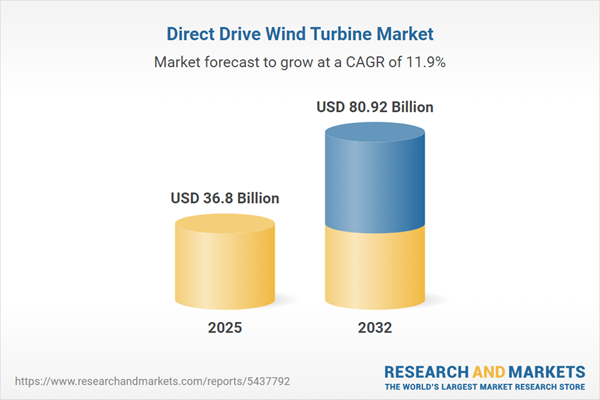Speak directly to the analyst to clarify any post sales queries you may have.
Direct drive wind turbines are redefining power generation for organizations aiming to accelerate clean energy adoption and operational efficiency. As global energy strategies continue to evolve, the direct drive wind turbine market presents unique opportunities for senior decision-makers committed to long-term value and sustainable infrastructure.
Market Snapshot: Direct Drive Wind Turbine Market Overview
The direct drive wind turbine market experienced robust expansion from USD 32.95 billion in 2024 to USD 36.80 billion in 2025 and is forecast to sustain a compound annual growth rate (CAGR) of 11.88%, reaching USD 80.92 billion by 2032. This momentum reflects the sector’s alignment with global renewable energy targets, technological advances, and increasing investment in both onshore and offshore deployments. Established players and new entrants alike are leveraging innovation and adaptation to maintain competitiveness in shifting regulatory and trade environments. Supply chain optimization and digitalization remain central as operators and investors strive for resilience and predictable returns.
Scope & Segmentation of the Direct Drive Wind Turbine Market
- End Users:
- Independent Power Producers
- Residential & Commercial
- National Utilities
- Regional Utilities
- Generator Technologies:
- Electrically Excited
- Permanent Magnet
- Applications:
- Offshore (Fixed-Bottom, Floating including Semi-Submersible and Tension Leg Platform)
- Onshore (Distributed Generation, Utility-Scale)
- Turbine Capacities:
- Less Than 2 MW
- 2 To 5 MW
- Greater Than 5 MW
- Geographical Regions:
- Americas (North America – United States, Canada, Mexico; Latin America – Brazil, Argentina, Chile, Colombia, Peru)
- Europe, Middle East & Africa (United Kingdom, Germany, France, Russia, Italy, Spain, Netherlands, Sweden, Poland, Switzerland, UAE, Saudi Arabia, Qatar, Turkey, Israel, South Africa, Nigeria, Egypt, Kenya)
- Asia-Pacific (China, India, Japan, Australia, South Korea, Indonesia, Thailand, Malaysia, Singapore, Taiwan)
- Key Companies:
- Siemens Gamesa Renewable Energy, S.A.
- Xinjiang Goldwind Science & Technology Co., Ltd.
- Enercon GmbH
- Yangzhou Mingyang Wind Power Group Co., Ltd.
- Envision Energy (Group) Co., Ltd.
- GE Renewable Energy
- Shanghai Electric Wind Power Group Co., Ltd.
- XEMC Wind Power Co., Ltd.
- Chongqing Haizhuang Wind Power Equipment Co., Ltd.
- Sany Heavy Industry Co., Ltd.
Key Takeaways for Senior Decision-Makers
- Direct drive technology offers lower maintenance requirements by eliminating gearboxes, improving long-term reliability for owners and grid operators seeking continuous uptime.
- Emerging regions are increasingly leveraging small and modular turbine capacities for distributed and rural electrification, diversifying market opportunities and supporting microgrid initiatives.
- Permanent magnet generator systems are driving a technological shift, maximizing energy density and efficiency, especially in offshore and high-yield environments.
- Digital infrastructure—including real-time analytics, predictive maintenance, and remote monitoring—enables proactive performance management and cost reduction.
- Strategic partnerships, including collaboration between OEMs and research bodies, accelerate innovation while lowering development risks and enhancing adaptability to regulatory changes.
- Localized manufacturing and supply chain diversification are essential strategies for mitigating logistical disruptions and maintaining project viability across volatile trade scenarios.
Tariff Impact on the Direct Drive Wind Turbine Market
Tariff measures, particularly from the United States since 2018, have recalibrated sourcing and production dynamics for wind turbine components. In response, manufacturers have relocated production closer to end markets, pursued joint ventures with domestic suppliers, and embraced alternative materials and manufacturing techniques to offset increased costs. Contractual flexibility and advanced procurement strategies have proven essential for sustaining growth and protecting return on investment against tariff-induced unpredictability.
Methodology & Data Sources
This report utilizes both primary and secondary research, incorporating structured interviews with industry experts, in-depth reviews of published materials, and input from regulatory and industry stakeholders. Triangulated quantitative modeling, SWOT analysis, cost modeling, and scenario planning underpin the reliability and robustness of all insights presented on the direct drive wind turbine market.
Why This Report Matters to the Wind Sector
- Facilitates strategic planning by offering clear analysis of technological trajectories, regional variations, and regulatory impacts.
- Empowers organizations with actionable data, enabling adaptation to supply chain changes and rapid adoption of digital solutions for operational excellence.
- Supports technology providers and investors in identifying high-potential segments and maximizing risk-adjusted returns amid evolving regulatory and economic landscapes.
Conclusion
Direct drive wind turbines represent a vital component of modern clean energy infrastructure. This report equips stakeholders with the insight required to capture emerging opportunities, address challenges, and shape future growth strategies in a rapidly advancing market.
Additional Product Information:
- Purchase of this report includes 1 year online access with quarterly updates.
- This report can be updated on request. Please contact our Customer Experience team using the Ask a Question widget on our website.
Table of Contents
3. Executive Summary
4. Market Overview
7. Cumulative Impact of Artificial Intelligence 2025
Companies Mentioned
The companies profiled in this Direct Drive Wind Turbine market report include:- Siemens Gamesa Renewable Energy, S.A.
- Xinjiang Goldwind Science & Technology Co., Ltd.
- Enercon GmbH
- Yangzhou Mingyang Wind Power Group Co., Ltd.
- Envision Energy (Group) Co., Ltd.
- GE Renewable Energy
- Shanghai Electric Wind Power Group Co., Ltd.
- XEMC Wind Power Co., Ltd.
- Chongqing Haizhuang Wind Power Equipment Co., Ltd.
- Sany Heavy Industry Co., Ltd.
Table Information
| Report Attribute | Details |
|---|---|
| No. of Pages | 190 |
| Published | October 2025 |
| Forecast Period | 2025 - 2032 |
| Estimated Market Value ( USD | $ 36.8 Billion |
| Forecasted Market Value ( USD | $ 80.92 Billion |
| Compound Annual Growth Rate | 11.8% |
| Regions Covered | Global |
| No. of Companies Mentioned | 11 |









